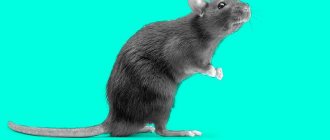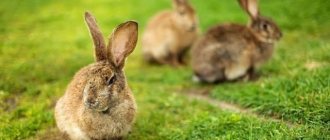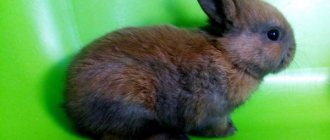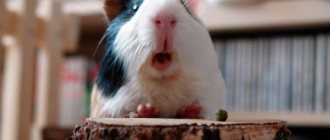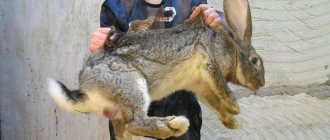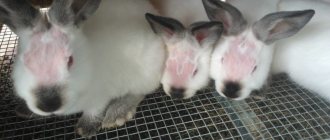Rabbits are cute and adorable creatures. But sometimes even they can cause discomfort to their owners. For example, when they beat persistently and loudly with their hind legs. What are the reasons for this behavior and what to do? Read on.
As annoying as the sound of rabbits thumping their hind legs may be, it is not the effect they are going for. In no case do these cuties want to anger their owner. They are definitely trying to communicate something. But what exactly is it about? It is necessary to observe and identify other reasons for such behavior.
How does a rabbit express aggression?
Experts believe that rabbits’ aggression towards their relatives is a completely normal phenomenon.
Juveniles often hit each other. With painless bites, herbivores can indicate to their family members that they must respect the hierarchy. How does a rabbit express aggression?
How can you tell if your pet is preparing to attack a person? Before the attack, he takes a characteristic pose - he presses his ears to his back and stretches his body forward. Herbivores that are kept alone in a cage often show aggression.
The less attention they show to the animal, the more aggressive it becomes. The long-eared cat can bite the owner on the forearm in case of resentment and anger
It is important to train your rabbit not to take out his bad mood on objects, as decorative pets can often start chewing shoes out of revenge.
Also, sick individuals can show aggression when trying to examine them.
It is important to train your rabbit not to take out his bad mood on objects, as decorative pets can often start chewing shoes out of revenge. Also, sick individuals can show aggression when trying to examine them.
General observations.
The more you communicate with rabbits, the more convinced you are that each of them is an individual. Everyone has their own character, inclinations, habits. Therefore, take these observations into account whenever possible. When a rabbit is comfortable, stress is minimized, he gets sick less, develops faster, and gains the required condition. I probably missed some points from the proposed topic. Perhaps your rabbits can express their emotions and feelings with other sounds and gestures. In this case, please share your observations and supplement the article. I will be very grateful to you!
Please share this article with your friends on social networks:
Please rate the article. Ask a question, discuss on the forum.
Movement and postures
To understand what the eared dog wants, it is important to take a closer look at its behavior:
The most common movement that demonstrates the joy of the long-eared animal is jumping and running. Often during games, animals run at high speed and flip over in a jump. Cheerfulness is also indicated by the pet jumping on chairs, sofas and tables. At the same time, they can shake their heads, inviting the owner to join in the fun. Eared cats often choose household items for games, so to avoid damage to them, it is best to purchase special balls. If the animal stands on its hind legs, then it explores the territory. A pet's mood is revealed by its ears. If they stand upright, the fluffy feels curiosity or tension
Herbivores also stand on their hind legs in order to better see objects located above. Sometimes with this behavior the pet asks to open the door for him, and if at the same time he pokes his nose at the owner, then he begs for attention and a treat. The position of lying on its side or back indicates relaxation of the animal. Most often, herbivores relax by stretching out their hind legs and resting their heads on their forelimbs
The behavior indicates a feeling of security and calm. If a pet rolls over onto its back, then this is a sign that it completely trusts its owner. You should not turn your long-eared dog over on your own, as this is a lot of stress for him, leading to tonic immobility. Rabbits love to rummage through things and towels. It is the natural instinct of herbivores to dig holes. To protect clothes from damage, it is recommended to place a box with earth or sand for your pet. Females like to move objects around, arranging them as they see fit, so it is best to hide all valuables. The rabbit sits tensely, which means it is dissatisfied. In this way, the pet can show that it does not like the human touch. The big-eared one can bend down to the floor even after rabbit fights, showing submission and the end of the fight. Freezing in place is a sign of fear. Feeling fear, the herbivore points its ears up or forward, its breathing quickens, and its eyes open wide. Thanks to this behavior, the animal tries to remain unnoticed and avoid danger. Why do rabbits clatter their hind legs? This is how they express their dissatisfaction. Rearranging the apartment can cause this behavior, since long-eared animals love stability, and even a small change in the environment can frighten the pet. By knocking its paws, an animal in the wild gives a danger signal. Decorative rabbits can behave this way at night out of boredom, fear or loneliness. Female rabbits may stomp during mating, as this process is stressful for them.
When an animal is stampeding, it is important not to chase it. Cardboard boxes or pieces of furniture can become a shelter for a herbivore. Under no circumstances should you invade the territory of a rabbit’s shelter and take it out of there.
To calm and lure your pet, just squat down near the house and offer him a treat. If the eared one does not make contact, then it is better to leave it alone for a while. When your pet feels curious, he may twitch his nose quickly and jerkily, sniffing everything around him. If a herbivore is alerted by some smell, it begins to stretch its head and quickly inhale air. However, sometimes frequent, jerky breathing indicates the development of disease. This symptom is typical for pneumonia, heart failure and overheating in the summer. Before eating, the rabbit may first sniff the food and nibble on it. Animals usually do this when new foods are added to their diet. By testing the teeth, they test the food for toxicity.
Under no circumstances should you invade the territory of a rabbit’s shelter and remove it from there. To calm and lure your pet, just squat down near the house and offer him a treat. If the eared one does not make contact, then it is better to leave it alone for a while. When your pet feels curious, he may twitch his nose quickly and jerkily, sniffing everything around him. If a herbivore is alerted by some smell, it begins to stretch its head and quickly inhale air. However, sometimes frequent, jerky breathing indicates the development of disease. This symptom is typical for pneumonia, heart failure and overheating in the summer. Before eating, the rabbit may first sniff the food and nibble on it. Animals usually do this when new foods are added to their diet. By testing the food on the tooth, they test the food for toxicity.
What do rabbit ears say?
Let me make a reservation right away that fold-eared breeds will not tell you anything using their ears. They will always have the same pose, that is, lowered. But all other rabbits have ears that are an inexhaustible source of information. Moreover, it matters not only how they are raised, but also how they are turned.
The ears are pressed to the body.
It is well known that in times of danger, when an animal is extremely wary or frightened, its appearance exactly resembles a lop-eared rabbit, its ears are lowered and flattened, its body is spread out on the ground. Your pet should not be allowed to remain in such a stressful state for a long time. Better move away and let him calm down. To improve the relationship, you can stroke, massage the corners of the jaws, talk in a quiet voice (they may be frightened by sharp and loud sounds), feed something tasty so that the hormone of joy is produced, and the rabbit begins to associate your presence with a feeling of comfort and security. Rabbits distinguish voices well and can already recognize people (their own and others) from them. In animals, instinct largely replaces and complements thinking. The same pinned position of the ears with a different position of the body can also indicate an aggressive state of the rabbit. But more on that below. With enough experience, you can easily determine the difference in the mood of your ward, primarily by their gaze. Far from being frightened, but rather focused, the rabbit’s eyes are hard to miss. And the body position is completely different. If the rabbit is angry, then the head is always raised, and the front paws are extended and spread to the sides to quickly transfer the center of gravity to them. The rabbit, ready to attack, looks directly at the object of attack. The front paws brought together indicate moderate irritability and an immediate attack should not be expected. If he also turns sideways, it means that it is no longer aggression that predominates, but banal resentment, confusion, offended feelings, so to speak.
How to decipher the turn of the ears?
And based on the position of the ears, experts determine four degrees of irritation:
- When the ears are turned to the sides and slightly down towards the back, this is only a warning to the enemy.
- Next, the position of the ears becomes vertical and the inner surface back - readiness for attack number one.
- But if you see that your ears are pressed as close to your back as possible, this is the highest degree of irritation. You should be wary of an attack at the slightest careless action or even movement on the part of the offender. By the way, it can be either another animal or the rabbit breeder himself.
- But if the rabbit is well-fed, calm and happy with everything, its erect ears are always turned forward. A slight deterioration in comfort is when one ear looks forward, the other is turned to the side or even lowered.
- If the eyes are closed, then the position of the ears will not say anything, they will simply be lowered. There is no need to try to determine the state of a sleeping rabbit that is watching its next dream.
When is a rabbit good?
If you notice the rabbit's ears are flattened and at the same time his head is lowered, so that his chin is pressed to the floor, then he is asking for affection and wants to be stroked. Often, in addition to this, the animal will lightly nudge your hand with its nose or push its tip under your palm. If suddenly the rabbit doesn’t like your advances or is tired of them, he will turn sideways or take a completely different pose. You must always remember that rabbits really don’t like it when something is done against their wishes. They can scratch and even bite. It also happens: you reached out your hand and want to pet your long-eared friend, but he lowered his head, tilted his ears to the sides, without pressing them back. This means that he doesn’t need affection now or the animal is actually scared. Better leave him alone for a while. It is especially undesirable to approach a frightened rabbit when it is outside the cage. He can gallop away so quickly that it will not be easy to catch him.
The rabbit raised his ears.
We are fine.
More often than not, the rabbit still keeps its ears raised. If at the same time he lies with all his paws tucked under him and his muzzle down, then there is no need to worry about him. Your client feels good, is in good shape, and is in a normal mood. In this position he can relax. The greater the degree of relaxation, the lower the back bends down. With extreme relaxation, the back takes a position parallel to the floor. Raised ears still indicate that the animal is not sleeping, but rather is monitoring its surroundings. A similar condition occurs if a rabbit lies in hot weather with its ears raised, but with its front and hind legs extended. It can lie on its side and look like it is dead and this can quite frighten its owner. But no need to worry, the rabbit just relaxed and decided to rest for a while. In this position he can even fall asleep. As soon as he feels or even suspects danger, the position will be changed to a more mobile one. A very common posture for a rabbit is when it sits on its hind legs and makes chewing movements. This suggests that everything is normal with the rabbit, he is in good shape.
It happens that your ward begins to shake his ears and rub them against the structure of the cage. This is a clear sign of ear scabies. Carefully check the condition of the ears and, if necessary, carry out a simple course of treatment. If otodectosis is not detected, then the rabbit simply gives you a sign to leave him alone. Perhaps you overdid it with caresses and holding in your arms.
How to solve a problem
If the female rabbit does not want to let the male in, the problem is eliminated based on the reasons for the refusal.
If a female rabbit is mating for the first time, it is recommended to take an experienced and proven male for her. Old females, on the contrary, are better off with young rabbits.
For full gestation of fruits and for pronounced hunting, female rabbits need vitamins. Trivit, which contains vitamin E, is suitable.
For an excessively fat female, the diet is reduced so that she acquires breeding condition. For exhausted animals, on the contrary, the amount of food is increased. Sick rabbits should be culled.
If the animal does not like the small room, move it to a larger enclosure. Experienced farmers advise placing the cage in the sun - the female will spontaneously develop a state of hunting.
It should be remembered that, regardless of the state of the body, female rabbits do not mate well:
- in autumn;
- in the summer heat;
- during the molting period.
It is also necessary to monitor the pregnancy of the animal - if the female is already fertilized, then she behaves aggressively. Females may bite the rabbits or make "moaning" noises that they don't mean to happen.
To stimulate rabbits to hunt, add celery to them and increase the lighting. The temperature should not be higher than 25 degrees and lower than minus 5.
There is a folk way to help a female rabbit - they put her in the cage where the male was previously sitting, so that she gets used to his smell. You can also place the female with an active male for 15 minutes. This is done several times, after which the rabbit herself will come into a state of hunting. In any case, for covering, you need to place the female in the rabbit's cage, and not vice versa.
Try not to make mistakes in rabbit breeding. Often, for beginners, the female rabbit is already fertilized because the farmer incorrectly determined the sex of the animals during seating and the male was sitting with the female.
Behavioral reactions of rabbits
Eared animals express their sensations, emotions, and states through certain behavior. Moreover, the same movements of individuals can have different reasons.
For example, an animal tapping its paws on the floor in different situations can mean fear, excitement, irritation, dissatisfaction.
In some cases, the rabbit thus strives to attract the owner’s attention and warn its relatives about imminent danger.
Some behavioral manifestations indicate unfavorable housing and feeding conditions. It is still impossible to unambiguously interpret the different behavior of these animals, since it often changes in accordance with the different conditions of their habitat.
Various bodily signals and behavior of eared animals are a means of their self-expression. Only by understanding animals can we find the most appropriate approach to them.
This is interesting: Keeping rabbits outside in winter - we present them in order
The meaning of bodily movements
An attentive owner will notice a good mood and manifestations of a rabbit's joy by chaotic jumping. Increased activity, recklessness, interest in various things and toys also indicate increased tone of animals. Such playfulness is often an invitation to play with him.
Caution, anxiety, and approximate activity of rabbits are expressed by standing on their hind legs, alert ears, and intense nose work. On the other hand, such interest could be a request for a treat or a walk.
Pressing to the floor, drooping ears and freezing indicate the animal’s fear, intense need, and stress. A manifestation of relaxation and contentment is rolling from the back to the tummy, legs spread out to the sides. Lying on your back with your stomach open speaks of trust in the person and a sense of security.
Careless neglect of a pet often causes it to become aggressive, which manifests itself in the form of an urge to bite.
A stomping rabbit that stomps its hind legs on the floor tries to attract attention for various reasons.
Additional Information
The rabbit transmits information intended for other animals (enemies or friends) to humans in different ways:
- characteristic poses;
- specific movements;
- olfactory marks;
- touches.
In the wild, the powerful thump of a rabbit's hind leg is a danger signal to all members of the pack. This is the most common non-verbal signal of rabbits living in stable groups - colonies. Both females and males knock with their paws; the signal has no sexual specialization.
Knocking with a hind paw is a danger signal for all members of a rabbit colony.
In short, that's it. A rabbit taps its paw when it is scared and wants to tell others about it. Everything that follows is additional and optional information.
Read more: all about wild rabbits
If Peter Rabbit winked at you, it means you understood his soul, this is what Biatrix Potter meant
Therefore, in order, about all the meanings of the “language” of rabbits.
Rabbits are considered emotional animals. The pet informs the owner about its condition in different ways: stomping its hind legs, spinning, jumping, scratching the cage, running. The non-standard behavior of a pet is explained in different ways:
He presses his ears to his head, lies down on the ground and freezes - the pet is frightened by something dangerous: your presence, loud sounds, moving the cage from place to place. Ears flat against the head also signify obedience. Stands on its hind legs, raises its ears, sniffs and listens - the rabbit is interested in what is happening around. If the pet looks at you and folds its paws, then it is begging for a treat. He weakly bites a person's fingers - he plays. If the bites are aggressive or cause blood, it means that he is dissatisfied with something: the quality of food, the cleanliness of the cage, loneliness. It is worth thinking about why the animal behaves this way. Lies on its back, spreads its paws in different directions - the animal is resting. If he allows you to scratch his belly, it means he completely trusts you as his owner. The rabbit stomps, runs, actively jumps, throws objects - plays, he is in a good mood. This is how the genes of wild ancestors appear in him, who use similar actions to escape persecution. Hugs into the corner of the cage, spends most of the day there - the pet is very scared
Perhaps loud noises, increased attention from small children, or another animal showing aggression are to blame.
Why don't hares knock their paws on the ground?
The order Lagomorpha (Lagomorpha) includes three families: hares, rabbits, and pikas. Rabbits and pikas live in stable groups, in burrows, while hares are solitary. Evolutionarily, rabbits have developed a system of warning signals that help them collectively escape from enemies when threatened. One of the rabbits signals the entire group of relatives, who immediately hide in holes. The second adaptation of rabbits is cecotorphy, eating feces. Feces (cekotorof) are rich in essential substances. Having received a danger signal, the rabbits sit out in the hole, while being saturated with useful substances, enjoying their own feces. This is very convenient in conditions of limited time spent on the pasture, on the surface of the earth.
Hares are solitary, they have no one to signal danger to, they just need to run away
Run, hare, run. Although some sources mention such strange signaling in hares. Or maybe this is a wrong translation? The thumping of pikas with their hind legs is not described in the literature, although they signal danger with a high-frequency sound, they are sometimes called “whistling hares.” Hares also do not knock on the ground or stumps with either their front or hind paws.
What to do if rabbits fight each other
Rabbits fight among themselves for the following reasons:
war for territory; struggle for dominance.
You can solve the problem in the following ways:
- sterilize or castrate (does not always help);
- seated in different cells;
- introduce the new animal to the others outside the cage and in no man's land;
- pet and feed the animals when they are together;
- do not interfere with the distribution of roles;
- pull apart only if the animal squeaks, there is blood, or two people are rolling around in a lump.
Thus, if your rabbit growls and bites, do not rush to get rid of it, this behavior has very simple reasons and indicates that your pet is very smart. This means that he will be able to learn the basics of education.
To solve the problem of aggression, it will take time and your love, but in return you will receive an affectionate fluffy ball that loves to bask next to you.
A simple action has many meanings
A rabbit's simple action signal can express a spectrum of animal states. It's easier to understand with analogies. An example is a person winking, what could be simpler and more understandable? Meanwhile, a wink can be a signal:
- take action;
- terminate the action;
- hint, for example erotic.
Photo. A simple action can mean a lot. In humans this is called body language. Simple actions of a rabbit can also be complex in the semantic transmission of information.
An example of how simple can be complex. In the world of the rabbit, not everything is simple either. Rabbits clatter their hind legs, as if expressing aggression. In fact, there can be several meanings for the same “word”.
Sign language
Running fast: Runs around the house at top speed, alone or chasing you or another rabbit, just for fun.
Jumping: An upward jump with a half-spin in the air and a twist, usually performed mid-run. The rabbit is happy.
Hitting with its hind legs: The rabbit stands and hits the floor hard with its hind legs. This is a sign of dissatisfaction.
Moving objects: pushing, pulling, biting bedding, towels or pillows. The rabbit rearranges everything at his own discretion.
Sits with its legs tucked under itself: the rabbit's front and back legs are hidden under its body. The bunny looks like she could fit in a loaf pan. Rabbits often sleep in this position. This means that the rabbit is a little cold or just comfortable.
The rug lies with its paws stretched out to the sides: The rabbit lies on its stomach on the floor, the hind legs are extended behind, and the front legs are extended in front. The rabbit can also lie on either side. Means calm, comfort and relaxation. Rabbits often sleep like this.
Digging: a burrowing, instinctive behavior.
Chewing: natural behavior.
Chin Marking: By rubbing objects with its chin, the rabbit marks its territory. On the chin there are odorous glands with an elusive odor to humans.
Circling: Circling around the legs of a person or another rabbit may be part of a mating dance or a means of attracting attention. Humming (vocalization) may also accompany circling.
Rock climbing: learning and play behavior.
Digging: natural behavior. This can also be a sign when the rabbit is excited about something, but does not intend to attack.
Changing the position of the ears: This is the rabbit's sonar to determine what is happening around it.
Both ears forward: Something attracts the rabbit's full attention.
One ear forward, one ear back: the rabbit is interested in two different sounds at the same time
Both ears are tilted back and pressed to the head: fear, a sign of submission or a desire to attack (the tail is straightened and the body is tense).
Eyes: Third eyelid at the corner of the eye. If it is strongly visible, then most likely it is a manifestation of fear.
Sudden fall on its side: The rabbit literally flops onto its side. The rabbit decided to rest and feels relaxed.
Invitation/Demand to Pet: The rabbit approaches you, nudges you and lowers its head to the floor in an extended position with its ears on the sides of its head and awaits your attention. Your rabbit wants attention and grooming from you.
Licking: an expression of love that has nothing to do with the need for salt.
Lunge: a sign of disapproval.
Attempting to mate: mating or dominant behavior.
Pinching: Feels like a slight tingling sensation and can mean several things (this is not the rabbit's intention to bite). The rabbit wants attention, a sign of courtship, an attempt to politely ask to get out of his way, a warning that your actions are undesirable for him.
Nose nudge: Rabbit nudges with its nose.
Trying to attract attention, asking him to pet him or asking him not to stand in the way
Stands on its hind legs: The rabbit stands on its hind legs and looks around.
Tail position: When straightened, it is a sign of interest or aggression. Wagging is a form of defiance or talking.
Throwing around the cage: play behavior or display of anger.
Stretched his paws forward, mouth open, growling: an expression of anger or a warning about violation of his territory.
To attract attention
Sometimes in such a universal way they show their playful attitude and also attract attention. In this case, you will notice that the rabbit looks very lively, active and energetic.
He may start pounding with one hind paw or two at once - as if right now he will rush off into the distance, his heels sparkling. But in reality, the pet wants to be paid attention to. It's like he's saying, “Hey, look at me! Do you see how fast I can run? How nimble and mischievous am I?” In this case, be sure to satisfy the rabbit's needs, pay attention to him, reward him with a treat and play.
Important! Rabbits are not particularly verbal creatures. And knocking with their hind legs is one of the surest ways for them to communicate something. They will never do this without a special reason. Therefore, be sure to pay attention to this signal and try to determine what your pet wants to tell you.
Brain inflammation
In order for the different systems of an animal’s body to function, the correct uninterrupted functioning of its brain is necessary. In this case, a living being reacts to a variety of external and internal factors, thinks, has different reflexes, etc. Also, if everything is in order with the brain, the rabbit moves quickly and clearly. If this organ is damaged, the consequences can be dire, and important functions are lost. If the rabbit breeder, together with veterinary specialists, fails to do anything, the animal dies.
If the pet's hind legs fail, this means there may be problems with the rabbit's brain; it may be inflamed. But such symptoms apply to several diseases.
With encephalitis, a sick rabbit does not stand up on its limbs, its head turns to the side. It is very difficult to cure an affected individual; even if in rare cases it works, a number of important impaired reflexes cannot be restored.
With encephalomyelitis, the brain is affected after an infectious disease. The animal's paws can be paralyzed. If you miss the moment when the first signs of the inflammatory process appear and do nothing, the rabbit can die within a day or four days.
With meningitis, both the brain and spinal cord become inflamed. The last resort is to kill the rabbit. But first you need to consult a veterinarian. Similar symptoms are observed with damage to the central nervous system, and it can be restored; specialized medications will be required; if you contact a specialized veterinary clinic at an early stage, the rabbit’s recovery is possible in a week.
As preventive measures to prevent paralysis of rabbit legs, you need to protect animals from falls, stress, communication with aggressive other pets at home or in the yard, consult a veterinarian once or twice a year, and give rabbits vitamin-mineral supplements or medications, for example, aminazine, monitor your diet and cell cleanliness.
Practical use of any rabbit signals
- sexual arousal (the female rabbit's immobile posture is the beginning of estrus, lifting her tail, raising her butt is a sign of readiness for mating);
- aggression (transmitted by sounds, throws, posture of readiness to throw)
- fear (posture of submission, sounds of submission).
The above is the most important information used when carrying out matings of male and female rabbits, uniting groups of rabbits for joint keeping (pit rabbit keeping), keeping a female rabbit with rabbits.
- animal (first) signaling system;
- human (second) signaling system.
Rabbits often make sounds, so the breeder needs to learn to recognize their meaning correctly.
- grinding teeth - pleasure, relaxation, good mood;
- loud chattering of teeth - pain;
- grunting - irritation, dissatisfaction, and with frequent and loud manifestations indicates the development of diseases;
- hissing and growling - anger and aggression;
- scream - severe pain, fear;
- Quiet squeaking of baby rabbits - cold or hunger.
We invite you to read why honey quickly thickens and turns white
Note! When rabbits purr, what does it mean? An animal may purr like a cat when it expresses its gratitude for a treat. Also, this behavior indicates that the pet loves its owner very much and feels affection, devotion and trust towards him.
Why do rabbits lick hands? Herbivores are social animals, staying in contact with others half the time. The rabbit licks its lips while performing hygiene procedures. When he begins to lick his relatives, in this way he strengthens family ties. If a pet begins to behave this way towards a person, this indicates that he has accepted him into his family.
Note! If an animal begins to lick all surrounding objects, this indicates its loneliness and a feeling of stress. When males jump on each other, they can play like this or show their dominance in the family
If a male behaves this way towards a female, this means sexual attraction
When males jump on each other, they can play like this or show their dominance in the family. If a male behaves this way towards a female, this means sexual attraction.
Understanding rabbit behavior is not difficult. The animal itself transmits the feelings it experiences. Aggression is not always a sign of anger; it may indicate loneliness of the pet. Long-eared animals usually do not hide their love for their owner. It manifests itself in the desire to lick a person and his things, rub himself on his legs and purr
It is important to learn to recognize warning signs indicating illness, since a timely response can save your pet’s life
The language of smells in the life of a rabbit.
Determines one's own - a stranger, a friend or an enemy.
Rabbits have a well-developed sense of smell. With its help, he distinguishes food even in the dark. Can recognize its owner or, for example, another of its brothers. This property plays an important role in the distribution of influence zones. The fact is that each rabbit has three categories of the concept of the surrounding territory: its own, someone else’s, and common. He doesn’t go into someone else’s unless absolutely necessary. In general, he coexists peacefully with his fellow tribesmen. He doesn’t let anyone in on his own. At first, when an uninvited guest appears, he behaves a little warily and studies him from a distance. Then one sits behind the other and begins to sniff, sometimes grunting. By smell, a rabbit primarily determines the gender of its visitor. If the individuals are of different sexes, then no act of aggression will follow. Such acquaintance often turns into mating games. If two males or two females get acquainted, then it’s not far from “hand-to-hand combat.” However, I have never noticed an aggressive reaction towards small bunnies. Of course, they are also sniffed, but then they lose all interest in what is happening. Also, by smell, a rabbit can remember a certain tribesman. Often during matings, the female does not cover if her cage is next to the male's cage. In such cases, rabbit breeders say that the rabbits sniffed.
How does the treatment work?
Paralysis of the hind limbs always entails side effects, so treatment includes various measures. The animal is given painkillers and anti-inflammatory drugs to relieve discomfort and prevent inflammation of the nerves and tissues at the site of the lesion. All medications are prescribed by a doctor, and the task of the animal owner is to remember all the recommendations and follow them exactly.
For rehabilitation, the rabbit needs to have a massage
It is necessary to massage the hind legs to quickly restore their mobility. This method avoids tissue death and improves blood flow. Artificial gymnastics will help the animal fully restore motor functions and coordination.
It is very simple to carry out: you need to slowly and carefully bend and unbend your paws for several minutes. If an individual with paralyzed hind legs generally feels well, then it can and should be taken for a walk in the fresh air and allowed to crawl on the grass under supervision
Sounds
Long-eared pets use not only body language - they also make a variety of sounds. For example, when a sexually mature animal is ready to mate, it may emit guttural screams, as cats often do. And baby rabbits call their mothers with a quiet squeak - adults can only make it when they are very scared or cannot figure out what is happening.
An angry rabbit will hiss and growl - be careful! An animal may bite you; it is better to wait until the pet calms down and then make contact with it.
But most often, new owners are interested in why rabbits grind/chatter their teeth. If the animal does this not during feeding or illness, such sounds indicate the highest degree of calm and pleasure. Happy rabbits express their love for their owner in this way.
Entertainment
Decorative rabbits can do touching things - in particular, beg their owners for tasty treats. They poke their noses and pester the owner in every possible way. Of course, you should not encourage such behavior, but if your pet occasionally receives pieces of vegetables, his love for you will only become stronger.
Young rabbits love to play with balls, but their attention is no less attracted to things that are not at all intended for entertainment - the animals happily push everything that can be rolled in front of them .
And, of course, due to their natural characteristics, long-eared animals simply love to dig .
And since in an apartment you can satisfy your archaeological needs only in a tray, rabbits happily dig through towels and rags. They find it especially fun to tuck the fabric underneath themselves. But it’s better not to leave clothes in direct reach - after the rabbit excavations you will have to iron everything.
Communication with humans and other rabbits
Rabbits often react to situations or stimuli by tapping their hind legs, jumping, or making unusual sounds.
It is important to correctly “read” your pet’s behavior in order to help him quickly get used to a new room or teach him how to communicate with other animals. You can eliminate aggression or irritation in different ways:
- place the pet in a quiet and calm place indoors;
- the construction of a spacious enclosure will allow the big-eared cat to walk freely at any time of the day;
- The best way to communicate is to lean towards the animal, rather than lifting it high to hold it in your arms.
If there are other rabbits in the apartment, it is important to ensure that the newcomer is not offended when meeting him. Also, sometimes the female knocks with her paws when she is placed in the male’s cage for mating
To correct the situation, it is recommended to postpone the mating procedure for several days (or another partner is selected for the female rabbit).
Decorative rabbits do not often show aggression or irritation. To prevent such behavior, you need to know the reasons that provoke such reactions.
It is also important to be able to correctly eliminate manifestations of fear, aggression, fright
Marks territory
Rubbing his chin —marking things. On the rabbit's chin there are submandibular glands that secrete a certain smell, so they rub against objects to tell everyone: “I marked this and it is now mine!”
Streams of urine while jumping , puddles in the wrong places - basically this is a sign of hunting: rabbits use marks to mark the territory and attract partners.
Scatters peas - droppings not collected in a heap, but scattered around the room - a sign that this territory belongs to the rabbit. This often happens when the rabbit’s habitat changes (moving, new enclosure, another room). If a fellow rabbit lives in the same room as a rabbit, such marks may appear more often.
Putting wool and hay into the mouth - a false pregnancy or pregnancy in a female. At this point, the female may become nervous, irritable and somewhat lost: she builds a nest from her wool, hoes, hay and her instincts tell her that she will soon have children! Sometimes, during a false pregnancy, rabbits stop eating. If there are frequent false pregnancies, the rabbit is castrated.
Communication with humans and other rabbits
Experts do not recommend picking up your pet without special reasons. Herbivores react poorly to a sudden loss of stability and the inability to control their body. The animal may become very frightened, freeze in fear, or begin to struggle. Sometimes attempts at release can end in injury to the pet. If the long-eared animal jumps into the owner’s arms, this indicates complete trust in the person, but even in this case the pet cannot be kept.
The rabbit taps its hind legs
Why do rabbits lick hands? Herbivores are social animals, staying in contact with others half the time. The rabbit licks its lips while performing hygiene procedures. When he begins to lick his relatives, in this way he strengthens family ties. If a pet begins to behave this way towards a person, this indicates that he has accepted him into his family. Most often it licks the owner's palm, in some cases the animal licks his things. Previously, it was generally accepted that the licking rabbit lacks nutrients, so it tries to compensate for them in this way. However, experts are sure that licking is a way of communication for long-eared animals.
Note! If an animal begins to lick all surrounding objects, this indicates its loneliness and a feeling of stress. When males jump on each other, they can play like this or show their dominance in the family
If a male behaves this way towards a female, this means sexual attraction
When males jump on each other, they can play like this or show their dominance in the family. If a male behaves this way towards a female, this means sexual attraction.
Understanding rabbit behavior is not difficult. The animal itself transmits the feelings it experiences. Aggression is not always a sign of anger; it may indicate loneliness of the pet. Long-eared animals usually do not hide their love for their owner. It manifests itself in the desire to lick a person and his things, rub himself on his legs and purr
It is important to learn to recognize warning signs indicating illness, since a timely response can save your pet’s life
The behavior of animals reflects their mood, well-being, and character traits, so you should carefully understand why the rabbit knocks its hind legs. This behavior carries an encrypted message, and understanding the body language of the wards will help you establish close contact with them. In addition, stress or illness of the animals may be among the reasons causing such actions. These manifestations require increased attention from the owners. This will create a comfortable environment for your pets.
Could this indicate danger?
The clattering of hind legs can be a signal of impending danger. For wild rabbits, in most cases, knocking with a paw means “Alarm!”, “Attention!”, “Danger!” So, in their natural habitat in their colonies, rabbits warn each other about predators, fires, hunters, and floods. Therefore, paw tapping is not a meaningless movement of an animal, but a signal that conveys important information.
The rabbit knocks its hind legs, why does it do this and what does it mean? What other signals do pets give to humans through their movements, postures and sounds? How to understand that a rabbit loves you? All about the peculiarities of a pet's body language is below.
Useful tips
Experienced rabbit breeders claim that even the most furious rabbit can be pacified, because 99% of these animals have a friendly disposition. To establish friendly relations with your pet and prevent its atypical behavior, first of all, take care of a spacious rabbitry and pay enough attention to its resident. And then, slowly, patiently walk towards your goal.
The following tips will help you with this:
Never remove an animal from its cage against its will. Do not, under any circumstances, resort to violence or hold someone in your arms. This will only aggravate the situation and intimidate the eared one even more.
When transplanting an animal into a new cage, do not interfere with its adaptation. Give him time to look around and get used to the new conditions. You can touch your pet when it begins to preen itself, wash itself, try the pre-supplied food, and carelessly stretches out on the floor.
Do not lean over a closed enclosure. Such actions will make the rabbit afraid, destroying his confidence in his own safety. To avoid associating the poor fellow with an attacking predator, squat near the cage door.
Talk to your rabbit often in a low, calm voice. But at the same time, you cannot stand at the cage at full height. Protect your ward from noise and screams.
Each time you put your hand into the cage, do not make sudden movements. Give the long-eared one a chance to sniff you, treat him with something tasty. In the future, this will allow the animal to get used to your smell, and it will stop seeing you as an enemy.
If your pet curls up into a ball when you try to pet it, it is better not to injure it.
Every time your rabbit calmly approaches you, reward him with affection or a treat. This will serve as reinforcement for the desired behavior.
If, despite good maintenance and treatment in the presence of a partner and good health, the animal continues to behave atypically, you need to let it know that you do not claim a place in the rabbit hierarchy
It is important here that the rabbit does not feel superior to the owner, so during the next attacks, calmly and confidently move the aggressor to the side, do not succumb to his provocations, ignoring the attacks.
During the initial stages of establishing contact with your cat, keep your hands as far away from his face as possible at all times. When your pet notices your hand from afar, he will begin to get used to it and calm down.
If after that he does not attack, you can gently try to pet him. Over time, the distance needs to be gradually reduced, and then even bring your hands close to the pet.
Read also: Types of decorative pumpkins photo
Aggression in rabbits cannot be caused by hostility towards the owner. As you can see, it is accompanied by certain reasons
It is important to immediately recognize and eliminate them, without causing discomfort to the silent ward, because such atypical behavior also causes discomfort to him. We hope our article will help you get along with your big-eared
Why does a decorative rabbit bite, aggression in rabbits. People are often shocked when they encounter aggression in rabbits. They cannot imagine that such timid and sweet rabbits can bite and scratch painfully. But aggression in rabbits is quite common. Research has shown that aggressive rabbits are more intelligent than timid ones. Once you begin to respect your rabbit and adhere to certain rules when interacting with him, rabbits will become attached to you very quickly.
When does a rabbit stop being silent and start screaming?
However, in rare cases, rabbits can still give their voice. In moments of extreme danger or severe pain, they emit a piercing scream or rather a squeal. They try to endure ordinary pain in silence. For wild rabbits, this innate quality often saves their lives, since enduring pain means preventing themselves from being detected by a predator. In households, on the contrary, it can play a cruel joke. Often a sick pet does not reveal itself in any way and thereby misleads inexperienced farmers. Only at the last moment does the rabbit suddenly begin to squeal loudly and immediately die in front of the owner’s eyes. But timely treatment could certainly correct the situation.
The loud screams of rabbits can also be heard during their martial arts. If, for example, a wild brother defends his right to a certain territory or two adult males were inadvertently placed in one cage, as well as during a planned replacement of a male during pit (aviary) keeping. At first, the animals seem to measure their strength, then the strongest begins to pursue the weaker. Sharp teeth turn out to be formidable weapons, the bites of which cause severe pain. Yes, and hitting with paws can lead to irreparable losses.
